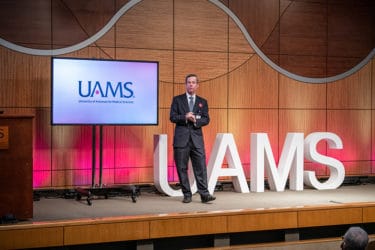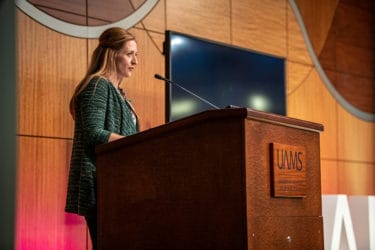View Larger Image

Chancellor Cam Patterson, right, listens as Sharanda Williams, chair of the House of Delegates, introduces him Feb. 23 at the State of the University presentation.
Image by Bryan Clifton
Chancellor’s State of the University Highlights Accomplishments in Challenging Year
| Just meeting expectations in clinical care, medical education and research would have been a crowning achievement during the COVID-19 global pandemic, said University of Arkansas for Medical Sciences (UAMS) Chancellor Cam Patterson, M.D., MBA. But instead, UAMS far exceeded expectations in almost every area.

Chancellor Cam Patterson speaks at the third annual State of the University presentation since he became chancellor in 2018.Image by Bryan Clifton
“This is my third State of the University address,” Patterson said Feb. 23 during the virtual meeting that reached a live audience of 900. “You’d think that by now this should be on a glide path, but as everybody knows the past year was anything but typical for UAMS and Arkansas. I am so pleased with the work that Team UAMS did in leading the state in addressing so many challenges from COVID-19.” (Click here to watch the State of the University).
Last week, UAMS staff and departments managed to cope with record low winter temperatures and snowfall to keep UAMS’ critical operations going. Patterson praised Environmental Services, grounds crews, Campus Operations, Nutrition Services, physicians, nurses, residents, patient care technicians, police and other employees who stayed overnight to make sure buildings were functioning and patient care wasn’t disrupted.
“You are indeed an incredible team,” the chancellor said. “That was highlighted yet again last week as we responded to the snow storm, a 100-year snow storm, which was the kind of weather I thought I had left behind when I moved to Arkansas. We managed to do everything we needed to do to provide clinical care to people in need, to stay safe and adapt to a situation far beyond normal.”
While the UAMS work force excelled this past year, university finances also beat expectations. Patterson said the university’s balance sheet for the current fiscal year is $23 million in the black.. While COVID-19 did reduce clinical revenues, the impact was significantly less than Patterson and other senior leaders anticipated when creating the budget.

Jennifer Huitt, Ph.D., president of the UAMS House of Delegates, also spoke briefly before the chancellor’s presentation.Image by Bryan Clifton
“We have continued doing quite well,” Patterson said. “This means we can continue doing the work that we are doing in Vision 2029, investing in our facilities and in new programs on research, educational and clinical sides to expand our mission.”
UAMS is tracking 222 targets in its Vision 2029 strategic plan. Patterson said 188 of those are on track, 29 already have been achieved and only nine are off track or at risk. He noted that of the four or five strategic planning processes he has participated in during his career, Vision 2029 is the only one of those that reflects its core missions and has stayed on course.
Stephanie Gardner, Pharm.D., Ed.D., UAMS provost and chief strategy officer, said online information about Vision 2029 and the progress of its implementation is about to get a new appearance and interface.
“We’re pretty excited about the transition and the progress,” Gardner said. “Our look will be different, but our metrics will be the same.”
Patterson then highlighted some of the many achievements of UAMS in the past year.
- UAMS, Arkansas Children’s, Baptist Health and Proton International in July signed a Letter of Intent to bring proton therapy — an alternative to radiation therapy for treating cancer — to Arkansas.
- UAMS HealthNow was well-positioned online to screen patients for COVID-19 while also reducing demand on outpatient clinics and helping prevent further spread of the virus.
- To address the physician shortage in Arkansas, especially in rural parts of the state, UAMS received $2.83 million in additional funding from the U.S. Department of Health and Human Services to improve access by expanding efforts to train and retain primary care physicians.
- In November, the university received a $500,000 gift from an anonymous donor to support the creation of a new regional campus in El Dorado. The gift will have a far-reaching impact, not only for El Dorado, but for patients in South Arkansas and across the state.
- The Federal Communications Commission in June provided $940,000 in funding to the university to deliver medical information to patients and providers across the state and for digital health technology to treat patients for COVID-19. It made possible digital health consultations to more than 300 medical facilities on COVID-19 best practices in the delivery of patient care.
- Despite the pandemic, 2020 was a boom year in funding. UAMS and its affiliate research institutions saw research funding grow by 43% this past year, with $158.1 million in grants by the end of the fiscal year, June 30.
- A first-of-its-kind study by UAMS Northwest Regional Campus researchers will test whether deliveries of healthy food, along with recipes and education materials, can help reduce Type 2 diabetes among food-insecure rural Arkansans.
Following the chancellor’s address, Patterson took questions from the online audience on a variety of topics including vaccinations and new construction.
The public vaccination clinic run by UAMS moved from the Freeway Medical Tower to a new location on West 12th Street.
Patterson said plans are in place to break ground this spring on a new surgical annex building on the main campus and that the $150 million energy project is on schedule and on budget.
Construction for the energy project on the east side of campus includes a new power plant as well as a new Radiation Oncology Center, a Proton Beam Center and a Fitness Court open for use by the UAMS community and the general public.
Patterson said that area of campus will be positively transformed once those projects are complete, improving access for patients as well as students, faculty and staff.